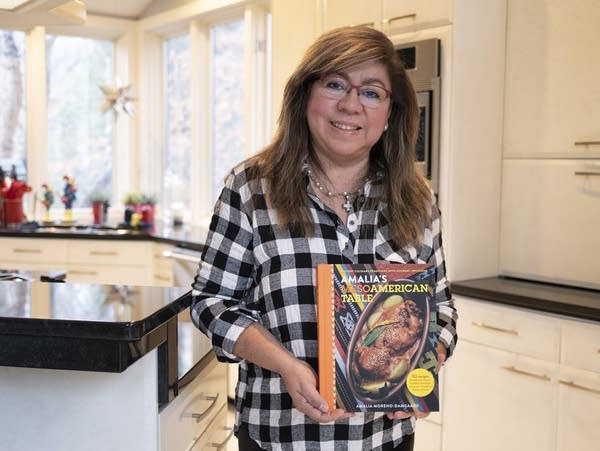Minnesota cookbook author draws Mesoamerican history, culture and food together
Go Deeper.
Create an account or log in to save stories.
Like this?
Thanks for liking this story! We have added it to a list of your favorite stories.

As she sat at her dining room table, Amalia Moreno-Damgaard spoke about her second cookbook and the food it celebrates as a bridge between cultures, including her native Guatemalan cuisine.
But she wasn’t always an entrepreneur, chef and author. Moreno-Damgaard spent 20 years in international banking. When her son was born, she knew what she wanted to do.
“For me, it has always been very important to eat healthy and to instill that in my son. So, I decided to stay home,” Moreno-Damgaard said.
Moving from banking to food may seem like a dramatic career shift. But Moreno-Damgaard was steeped in the cuisine, cooking with her maternal grandmother in Guatemala.
Turn Up Your Support
MPR News helps you turn down the noise and build shared understanding. Turn up your support for this public resource and keep trusted journalism accessible to all.
Her second cookbook, “Amalia’s Mesoamerican Table” was released in October. It’s a follow-up to her first book, “Amalia’s Guatemalan Kitchen” published in 2012.
The latest book contains recipes from the Mesoamerican region, which spans from south-central Mexico to Panama. But the book is more than recipes. It’s a cultural look at the foods in those regions.
“It’s traditional cuisine. It's a lot of history, a lot of culture of a territory that is not well known in terms of cuisine. There's a lot of information out there in terms of anthropology, in terms of archaeology, but not a lot about this important region of the world that’s a cultural and agricultural hub,” she said.
The book begins with a map outlining the periods of the Olmec, Aztec, Mayan and other ancient civilizations.

“Creating this map was very challenging. I actually started hand drawing this map and then coming up with all this information to support the map. Many people don’t realize that there are also very ancient cultures in the rest of the Central America region. That took more time to research,” Moreno-Damgaard said.
Her research included trips with personal tours at the Museum of Anthropology in Mexico and phone interviews with the Smithsonian Institution.
Moreno-Damgaard, who trained at Le Cordon Bleu, said readers will find traditional cuisine she adapted to her own style, combined with the cooking she learned from her grandmother.
Amalia’s Mesoamerican Table has 132 recipes. Her first book has 170.
When asked if she had a favorite recipe, Moreno-Damgaard answered with not an individual dish, but a foundational group: “It will probably be the Mayan dishes. Because Mayan cuisine is the core of Guatemala. But I would say that Mayan cuisine and the stews from Mayan cuisine are some of my favorites.”

In this second book, she describes the many plants native to the area which are used in cooking. Some of the recipes reflect the variety of ingredients, most largely unknown in the U.S.
“This is an area where the Earth is alive. There are some 104 edible plants that have been identified, about 50 percent of those are in Guatemala, that is the center and the core of Mesoamerica,” she said.
The book contains what she calls a pantry. These pages allowed her to give more detail about the ingredients she uses in the recipes.
Moreno-Damgaard said Latin American cuisine is just being discovered in the United States. Dishes from some countries are only superficially known. But she said they also need to be shared in the proper way. And by someone native to the culture.

“They need to be shared authentically. And they need to be shared with respect. They need to be shared in the way that they are meant to be shared with tradition, with stories with the right ingredients with the right techniques,” Moreno-Damgaard said.
Moreno-Damgaard said she sees food as the common denominator between cultures.
“I see food as a way to share the table with anyone, not just Latin American people, but with anyone from any part of the world. Food is a conduit to introducing people to a new culture. Food is a conduit to bringing people in conversations that are not necessarily related to food, but you can talk about anything under the sun when you're eating a good dish,” she said.
Vicki Adame covers Minnesota’s Latino communities for MPR News via Report for America, a national service program that places journalists into local newsrooms to report on undercovered issues and communities.


